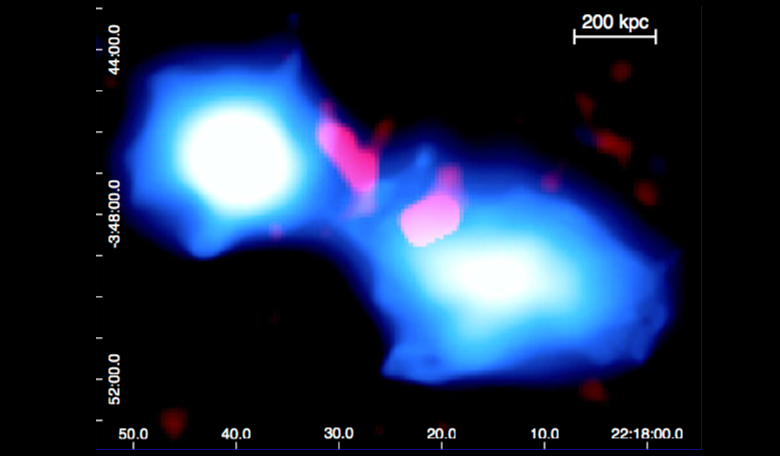Astronomers in the Netherlands have spotted a new example of an early phase galaxy cluster merger, that is linked by a bridge of X-rays. Less than a handful of early phase cluster mergers have been observed, making this a rare opportunity to witness the ensuing chaos that results when the largest gravitationally bound objects in the Universe start to collide.
Galaxy clusters are expected to grow primarily via merging processes with other galaxies or other groups of galaxies and it is the the head-on collision of 1E2216.0-0401 and 1E2215.7-0404, dubbed 0401 and 0404 respectively, that a team based at the SRON Netherlands Institute for Space Research and Leiden Observatory have imaged using data taken from the Suzaku satellite and the XMM-Newton telescope.
During a merger of galactic proportions, an enormous amount of energy is released (around 1064 erg which is equivalent to 1057 joules) that is fed into a number of processes, such as heating, turbulence and boosting the intergalactic magnetic field.
Cosmological simulations also predict that as the gas between the two clusters collides, the gas at the front of the collision compresses, warming it up and resulting in a shock structure. The team's data reveal this expected shock structure and have estimated its age to be 50–100 Myr based on the Mach number and the pre- and post-shock temperature of the gas. The team also estimate that 0401 and 0404, which are separated by a projected distance of 640 kpc, will undergo “core-passing” in approximately 0.3–0.6 Gyr.
Along with a bridge glowing in X-rays, the team detect two main regions of diffuse radio emission which are approximately in the same location as the X-ray bridge between the clusters. Diffuse radio emission has been observed within the intercluster medium (ICM) of a large number of galaxy clusters and is therefore thought to be formed as a consequence of shocks and turbulence in massive clusters. Accordingly, the team, whose lead author on the research paper is H Akamatsu from SRON, speculate that their detected radio sources are most likely related to the merger event.
Of the four examples of early phase cluster mergers reported so far, only one reported a signature of a merger shock in X-ray data and none provided concrete evidence of radio emission connected with the shocks. Therefore, this seldom observed kind of merger spotted by Akamatsu and team will help astronomers to understand the physics involved in the early phase of cluster merges, which at present is poorly understood.
For further information on this research, please see http://arxiv.org/pdf/1608.01669.pdf











